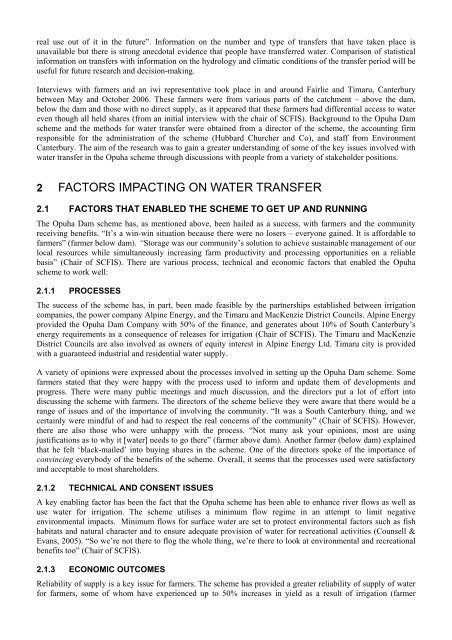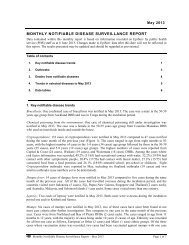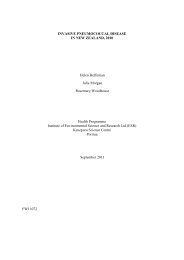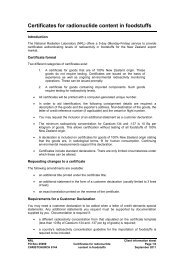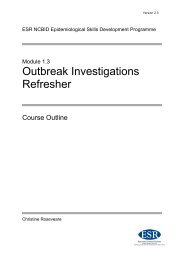Water Transfer in Context â A New Zealand Case Study
Water Transfer in Context â A New Zealand Case Study
Water Transfer in Context â A New Zealand Case Study
Create successful ePaper yourself
Turn your PDF publications into a flip-book with our unique Google optimized e-Paper software.
eal use out of it <strong>in</strong> the future”. Information on the number and type of transfers that have taken place isunavailable but there is strong anecdotal evidence that people have transferred water. Comparison of statistical<strong>in</strong>formation on transfers with <strong>in</strong>formation on the hydrology and climatic conditions of the transfer period will beuseful for future research and decision-mak<strong>in</strong>g.Interviews with farmers and an iwi representative took place <strong>in</strong> and around Fairlie and Timaru, Canterburybetween May and October 2006. These farmers were from various parts of the catchment – above the dam,below the dam and those with no direct supply, as it appeared that these farmers had differential access to watereven though all held shares (from an <strong>in</strong>itial <strong>in</strong>terview with the chair of SCFIS). Background to the Opuha Damscheme and the methods for water transfer were obta<strong>in</strong>ed from a director of the scheme, the account<strong>in</strong>g firmresponsible for the adm<strong>in</strong>istration of the scheme (Hubbard Churcher and Co), and staff from EnvironmentCanterbury. The aim of the research was to ga<strong>in</strong> a greater understand<strong>in</strong>g of some of the key issues <strong>in</strong>volved withwater transfer <strong>in</strong> the Opuha scheme through discussions with people from a variety of stakeholder positions.2 FACTORS IMPACTING ON WATER TRANSFER2.1 FACTORS THAT ENABLED THE SCHEME TO GET UP AND RUNNINGThe Opuha Dam scheme has, as mentioned above, been hailed as a success, with farmers and the communityreceiv<strong>in</strong>g benefits. “It’s a w<strong>in</strong>-w<strong>in</strong> situation because there were no losers – everyone ga<strong>in</strong>ed. It is affordable tofarmers” (farmer below dam). “Storage was our community’s solution to achieve susta<strong>in</strong>able management of ourlocal resources while simultaneously <strong>in</strong>creas<strong>in</strong>g farm productivity and process<strong>in</strong>g opportunities on a reliablebasis” (Chair of SCFIS). There are various process, technical and economic factors that enabled the Opuhascheme to work well:2.1.1 PROCESSESThe success of the scheme has, <strong>in</strong> part, been made feasible by the partnerships established between irrigationcompanies, the power company Alp<strong>in</strong>e Energy, and the Timaru and MacKenzie District Councils. Alp<strong>in</strong>e Energyprovided the Opuha Dam Company with 50% of the f<strong>in</strong>ance, and generates about 10% of South Canterbury’senergy requirements as a consequence of releases for irrigation (Chair of SCFIS). The Timaru and MacKenzieDistrict Councils are also <strong>in</strong>volved as owners of equity <strong>in</strong>terest <strong>in</strong> Alp<strong>in</strong>e Energy Ltd. Timaru city is providedwith a guaranteed <strong>in</strong>dustrial and residential water supply.A variety of op<strong>in</strong>ions were expressed about the processes <strong>in</strong>volved <strong>in</strong> sett<strong>in</strong>g up the Opuha Dam scheme. Somefarmers stated that they were happy with the process used to <strong>in</strong>form and update them of developments andprogress. There were many public meet<strong>in</strong>gs and much discussion, and the directors put a lot of effort <strong>in</strong>todiscuss<strong>in</strong>g the scheme with farmers. The directors of the scheme believe they were aware that there would be arange of issues and of the importance of <strong>in</strong>volv<strong>in</strong>g the community. “It was a South Canterbury th<strong>in</strong>g, and wecerta<strong>in</strong>ly were m<strong>in</strong>dful of and had to respect the real concerns of the community” (Chair of SCFIS). However,there are also those who were unhappy with the process. “Not many ask your op<strong>in</strong>ions, most are us<strong>in</strong>gjustifications as to why it [water] needs to go there” (farmer above dam). Another farmer (below dam) expla<strong>in</strong>edthat he felt ‘black-mailed’ <strong>in</strong>to buy<strong>in</strong>g shares <strong>in</strong> the scheme. One of the directors spoke of the importance ofconv<strong>in</strong>c<strong>in</strong>g everybody of the benefits of the scheme. Overall, it seems that the processes used were satisfactoryand acceptable to most shareholders.2.1.2 TECHNICAL AND CONSENT ISSUESA key enabl<strong>in</strong>g factor has been the fact that the Opuha scheme has been able to enhance river flows as well asuse water for irrigation. The scheme utilises a m<strong>in</strong>imum flow regime <strong>in</strong> an attempt to limit negativeenvironmental impacts. M<strong>in</strong>imum flows for surface water are set to protect environmental factors such as fishhabitats and natural character and to ensure adequate provision of water for recreational activities (Counsell &Evans, 2005). “So we’re not there to flog the whole th<strong>in</strong>g, we’re there to look at environmental and recreationalbenefits too” (Chair of SCFIS).2.1.3 ECONOMIC OUTCOMESReliability of supply is a key issue for farmers. The scheme has provided a greater reliability of supply of waterfor farmers, some of whom have experienced up to 50% <strong>in</strong>creases <strong>in</strong> yield as a result of irrigation (farmer


